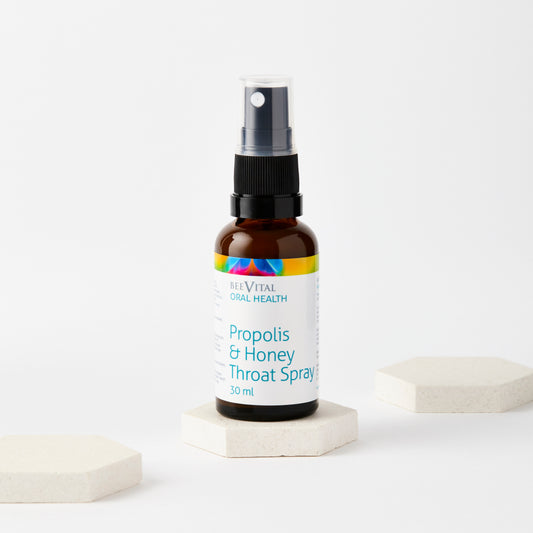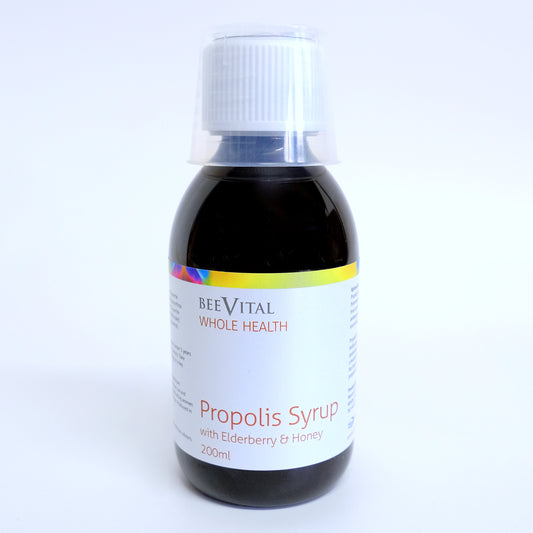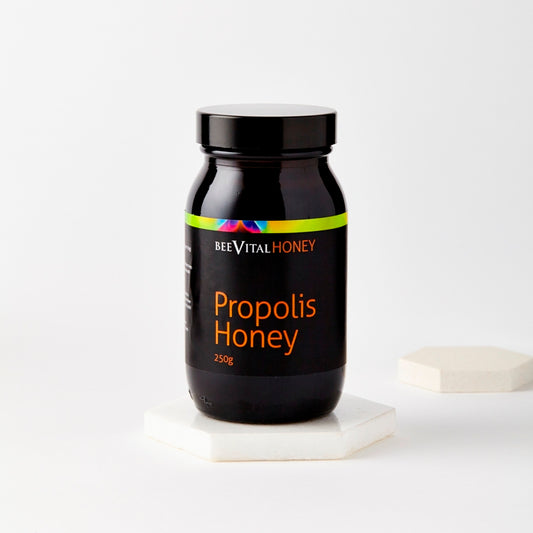Collection: Honey
Most people know honey is delicious. On toast or hot buttered crumpets especially! Honey has been an important food source for people all around the world for millennia.
Today honey is often used in cooking and baking as well as being a natural sweetener used in hot drinks. Most commercial honey is blended – a combination of two or more different honeys made from different flowers. Some honey is polyfloral – where the bees have access to lots of different wild flowers. Some beekeepers locate their hives in areas where only one type of flower grows. This results in monofloral honey, such as heather honey from Yorkshire.
Honey is made by bees from nectar collected from flowers. The bees process the honey, by consuming and regurgitating it, before storing it in the wax honeycomb. Excess water is evaporated, reducing the water content. This means the honey can be stored without fermenting for a long time. The honeycomb is capped with wax to protect the honey. Bees eat honey themselves, during cold weather.
A single beehive generally houses between 20,000 and 40,000 bees. Between them they will produce an average of 29kg of honey per year. Each bee will visit thousands of flowers each day. Generally flying up to a mile from their hives, honey bees have been known to fly up to 5 miles to find food!
Honey has a significance in world religions. In Ancient Greece it was said that the food of Zeus and the 12 Gods of Olympus ate honey. Honey also has a strong presence in Judaism due to the many references to honey in the Torah. Biblical references to honey include the description of Isreal as the land of “milk and honey”. The book of Proverbs encourages the consumption of honey, but also that “It is not good to eat too much honey” (Proverbs 25:27).
As well as being a valuable food source, honey has also been used as a natural remedy for thousands of years. Evidence suggests that applying honey to wounds and burns can speed up the healing time. Honey has well-documented antibacterial properties. There has been renewed interest in this aspect of honey due to the increase in antibiotic resistance in recent years. The World Health Organisation recommend honey as a treatment for coughs and sore throats. We use honey in our Propolis & Honey Throat Spray as well as our Propolis Syrup.
Whilst evidence for many folk remedies can be inconclusive, there is strong evidence to support the antibacterial properties of honey. However, because it is a natural product which varies from region to region, standardising its use as a medicine is difficult. We have selected a range of research papers which support the use of honey as a natural remedy. Please explore the research for yourself. Modern science is finally unlocking the hidden secrets of nature’s medicine cabinet!
Research Papers
Wound Healing
The antibacterial effects of honey present a useful option in managing both acute and chronic wounds. A meta-analysis published in the Journal of Tissue Viability, suggested honey has ‘all the beneficial criteria to be considered an ideal dressing material’ for various wounds. Studies showed that honey was superior to standard treatment for both acute wounds (lacerations & burns) and chronic wounds (pressure sores, diabetic foot and venous leg ulcers).
Oryan A, Alemzadeh E, Moshiri A. Biological properties and therapeutic activities of honey in wound healing: A narrative review and meta-analysis. J Tissue Viability. 2016 May;25(2):98-118
Available at: https://pubmed.ncbi.nlm.nih.gov/26852154/
Cough and Sore Throat
A research paper published in the British Medical Journal of Medicine analysed 14 separate trials in the use of honey for symptomatic relief of an upper respiratory tract infection. They concluded that honey was superior to usual care and provided a cheap alternative to antibiotics, by improving symptom scores and reducing cough frequency and severity.
Abuelgasim H, Albury C, Lee J, Effectiveness of honey for symptomatic relief in upper respiratory tract infections: a systematic review and meta-analysisBMJ Evidence-Based Medicine 2021;26:57-64.
Available at: https://ebm.bmj.com/content/26/2/57.long
Antibacterial
Honeys antibacterial properties are due its ability to naturally produce hydrogen peroxide, a common antiseptic, found in some medicated mouthwashes and toothpastes. Additionally the acidic environment and high sugar content of honey constitute a difficult environment for bacterial growth.
Studies show honey has potent antibacterial activity against organisms E.Coli, Pseudomonas, Staph Aureus and Proteus which cause life threatening infection in humans. Some honeys have better antibacterial activity than others, dependent on the quality, which varies from artificial, pasture and Manuka honeys. To date microbial resistance to honey has never been reported.
Mandal MD, Mandal S. Honey: its medicinal property and antibacterial activity. Asian Pac J Trop Biomed. 2011;1(2):154-160.
Available at: https://www.ncbi.nlm.nih.gov/pmc/articles/PMC3609166/
-
Propolis & Honey Throat Spray
Regular price From £8.00 GBPRegular priceUnit price / per -
Propolis Syrup with Elderberry & Honey
Regular price £13.50 GBPRegular priceUnit price / per -
Propolis Honey
Regular price £13.25 GBPRegular priceUnit price / per -
Pollen Honey
Regular price £12.95 GBPRegular priceUnit price / per














